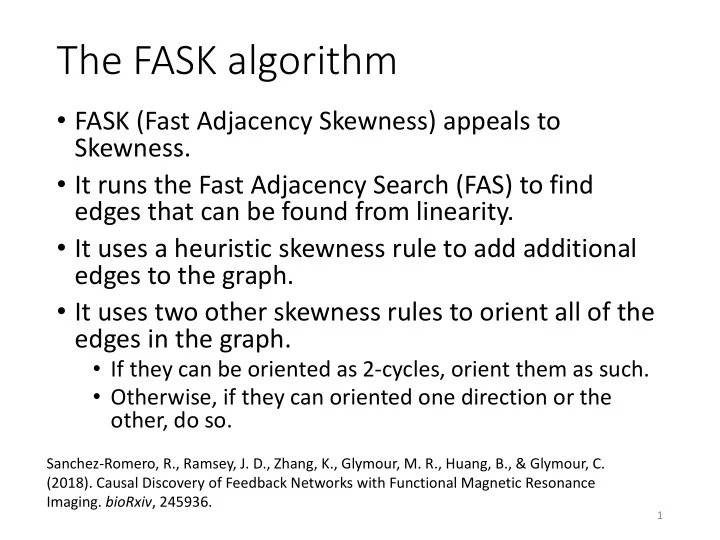

The FASK algorithm • FASK (Fast Adjacency Skewness) appeals to Skewness. • It runs the Fast Adjacency Search (FAS) to find edges that can be found from linearity. • It uses a heuristic skewness rule to add additional edges to the graph. • It uses two other skewness rules to orient all of the edges in the graph. • If they can be oriented as 2-cycles, orient them as such. • Otherwise, if they can oriented one direction or the other, do so. Sanchez-Romero, R., Ramsey, J. D., Zhang, K., Glymour, M. R., Huang, B., & Glymour, C. (2018). Causal Discovery of Feedback Networks with Functional Magnetic Resonance Imaging. bioRxiv , 245936. 1
A Kind of Skewness • Let X be smoothly positively skewed about 0 (for centered X) if for every b, the area under the p.d.f. from –b to 0 is greater than the area under the p.d.f. from 0 to b. 0 -b b 2
Assumptions 3
Basic idea of the left-right rule Lemma 1. Let X _||_ eY, X, eY smoothly positively skewed, X, e Y centered, Y = aX + e Y , a > 0. Then E(Xe Y ) in regions A + B + C + D must necessarily be negative . The picture shows a = 1. 4
5
And it follows after a few steps of algebra: This is the Left-Right rule. It’s a pairwise orientation rule. This is almost saying corr(X, Y | X > 0) > corr(X, Y | Y > 0) but without the centering of the variables. Theorem 1 is true if X à Y, a > 0, X, Y, e X , and e Y smoothly positively skewed Any problem you can transform into a problem like this you can give an answer to. 6
Additional flips • Need to “flip” the direction for each of the following that holds: • The skewness of X is negative. • The skewness of Y is negative. • Additionally, if corr(X, Y) < delta (default value -0.2) after the previous flips 7
Heuristic Skewness Adjacency Rule • If X and Y are independent, then abs(corr(X, Y | X > 0) - corr(X, Y | Y > 0)) = abs(0 – 0) = 0. So if this absolute difference is different from zero, then there must be a trek between X and Y. • If it’s very different from zero , we add an adjacency (heuristic). • We use a cutoff of 0.3, which we got from experience with fMRI data. • It might be good to go back and condition on intermediaries in the graph to see if the edge can be explained away. We didn’t do this. 8
2-Cycles • The Left-Right rule assumes X—Y is not a 2-cycle, so we have to orient those first. • If X and Y have no adjacents, we simply check to see if corr(X, Y) != corr(X, Y | X > 0) or corr(X, Y | Y > 0), using a T-test. • For control 2-cycles (where coefficient in opposite directions have opposite signs), we check signs of the differences. For X à Y these will be the same, but for control 2-cycles they will be different. • If X and Y have adjacents, we condition on subsets of the adjacents. (See theory for the Cyclic Causal Discovery algorithm (Richardson and Spirtes). • We don’t try to detect confounders, so confounders will look like 2-cycles in FASK output if they are detectable. • We used a single-subject sample size of 500 since MRI scanning protocols are better now. 9
Recommend
More recommend